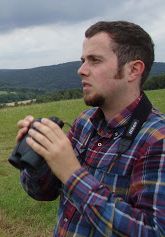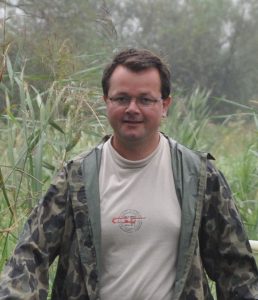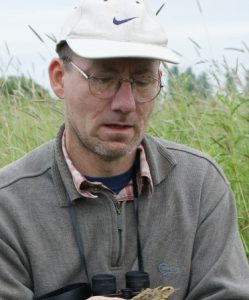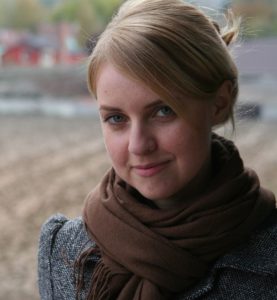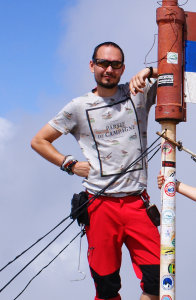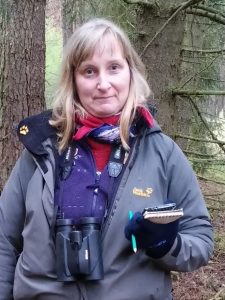
Research gate
ORCID ID: 0000-0001-6340-0253
Research interests
Ecology, Nature conservation, Ecosystem services in agricultural and forest ecosystems, Bird conservation
CV
2002 PhD in agricultural sciences in the field of biology. (August Cieszkowski Agricultural University (currently Poznań University of Life Sciences)
- MSc in Environmental Management University of Amsterdam, Amsterdam (The Netherlands)
1991 MSc in Biology Eotvos Lorant University (currently University of Budapest), Budapest (Hungary)
Work experience
2021 Department of Zoology PULS postdoc
2013–2017 Department of Zoology PULS,
2012–2015 postdoc Adam Mickiewicz University, Poznań (Poland)
1998–2006 Institute of the Environment and the Ministry of the Environment, Budapest (Hungary)
1995–1996 assistant Plant Protection Institute of the Hungarian Academy of Sciences, Nagykovacsi, Budapest (Hungary).
1992–1994 assistant Institute of Ecology and Hydrobiology of the Hungarian Academy of Sciences, Vacratot (Hungary)
Projects
2020- Ecosystem Services provided by the main ecosystem types of in Poland – an applied approach (ECOSERV-POL) Norwegian grant
2017-2020 BocianiMy w lasach. Good practices for the protection and management of the black stork population in forest areas. POIS: 020300-00-0154 (participation in the project 2018-2019)
2013-2017 – Linking farmland Biodiversity to Ecosystem seRvices for effective Eco functional intensification (LIBERATION) – 7th Framework Program of the European Union
2013-2015. Learning from Landscapes (Grundtvig, 2012-1-HU1-GRU06-07023 4)
2012-2015 – Analysis of Civil Security Systems in Europe (ANVIL). 6th Framework Program of the European Union
List of publications
Takács, V., Kujawa, D., O’Brien, D., Mizera, T. Can Intensive forest management be compatible with bird conservation? The case of woodlark Lullula arborea in Polish commercial forests, Forest Ecology and Management (major revisions needed)
Banaszak-Cibicka, W., Takács, V., Kęsy, M., Langowska, A., Blecharczyk, A., Sawińska, Z., Sparks, T.H., Tryjanowski, P. (2019). Manure application benefits bumblebees Bombus spp. in intensive farmland, Basic and Applied Ecology 36.26-33. https://doi.org/10.1016/j.baae.2019.03.005
Świtek, S., Takacs, V., Śawinska, Z., Kosiada, T., Tryjanowski, P. (2019). Mineral nitrogen fertilizers remain a crucial factor even in the ecological intensification of agriculture. Acta Agr. Scand. Section B- Soil and Plant Sciences 2019, 69:4, 311-316 DOI: 10.1080/09064710.2018.1564787https://doi.org/10.1080/09064710.2018.1564787.
Matczak, P., Takács, V. Reversal of current. The small retention program in the Polish forests. Hartmann, T., Slavikova, L., McCarthy, S., Schanze, J. (eds.) Nature-Based Flood Risk Management on Private Land. P 23-39. Springer, ISBN 978-3-030-23841 https://doi.org/10.1007/978-3-030-23842-1
Garratt, M. P. D., Bommarco, R., Kleijn, D., Martin, E., Mortimer, S. R., Takács, V., Redlich, S., Senapathi, D., Van Gils, S. , Van Der Putten, W. H., Potts, S. G. (2018). Enhancing Soil Organic Matter as a Route to the Ecological Intensification of European Arable Systems. Ecosystems. http://doi.org/10.1007/s10021-018-0228-2.
Gagic, V., Kleijn, D., Báldi, A., Boros, G., Jørgensen, H. B., Elek, Z., Garratt, M. P. D., de Groot, A., Hedlund, K., Kovács-Hostyánszki, A., Marini, L., Martin, E., Pevere, I., Potts, S. G., Redlich, S., Senapathi, D., Steffan-Dewenter, I., Świtek, S., Smith, H. G., Takács, V., Tryjanowski, P., van der Putten, W.H., van Gils, S., Bommarco, R. (2017). Combined effects of agrochemicals and ecosystem services on crop yield across Europe. Ecology Letters 20(11). DOI 10.1111/ele.12850.
Świtek, S., Jankowiak, L., Rosin, Z. M., Sawinska, Z., Steppa, R., Takács,V., Zbyryt, A., Tryjanowski, P. 2017. Jak zachować wysoki poziom bioróżnorodności na obszarach rolniczych w Polsce? Identyfikacja najważniejszych problemów badawczych. Wieś i Rolnictwo. 177(4). doi: 10.7366/wir042017/06.
Tryjanowski, P., Møller, A. P., Morelli, F., Biaduń, W., Brauze, T., Ciach, M., Czechowski, P., Czyż, S., Dulisz, B., Golawski, A., Hetmański, T., Indykiewicz, P., Mitrus, C., Myczko, L., Nowakowski, J., Polakowski, M., Takács, V., Wysocki, D., Zduniak, P. (2016). Urbanization affects neophilia and risk-taking at bird-feeders. Scientific Reports, 6. http://doi.org/10.1038/srep28575.
Skórka, P., Sierpowska, K., Haidt, A., Myczko, L., Ekner-Grzyb, A., Rosin, Z. M., Kwieciński, Z., Suchodolska, J., Takács, V., Jankowiak, L., Wasielewski, O., Graclik, A., Krawczyk, A. J., Kasprzak, A., Szwajkowski, P.,Wylegała, P., Malecha, A., W. Mizera, T., Tryjanowski, P. (2016). Habitat preferences of two sparrow species are modified by abundances of other birds in an urban environment. Current Zoology, 62, 357–368. http://doi.org/10.1093/cz/zow069.
Jankowiak, L., Polakowski, M., Kułakowski, T., Świętochowski, P., Tumiel, T., Broniszewska, M., Takács, V. (2015). Habitat and weather requirements of diurnal raptors wintering in river valleys. Biologia (Poland), 70(8), 1136–1142. http://doi.org/10.1515/biolog-2015-0117.
Brazova, V.K., Matczak, P., Takács, V. (2014). Evolution of civil security systems: the case of three Central European countries. Journal of Risk Research. 18(6). 789-806. DOI: 10.1080/13669877.2014.913659.
Wylegała, P., Radziszewski, M., Iciek, T., Mielczarek, S., Krąkowski, B. Maciej, S., Cierplikowski, D., Kaczorowski, S., Kiszka, A., Plata, V., Kaczmarek, S. Nowak, B., Przystański, M., Ilków, M., Wyrwał, J., Bagiński, W., Takács, V. Rosiński, T. Pietrzak, T., (2014). Liczebność i rozmieszczenie lęgowej populacji śmieszki Chroicocephalus ridibundus oraz zausznika Podiceps nigricollis w Wielkopolsce w roku 2013. Ptaki Wielkopolski 3. 18-20.
Przybylska, K., Haidt, A., Myczko, L., Ekner-Grzyb, A., Rosin, Z. M., Kwieciński, Z., Tryjanowski, P., Suchodolska, J., Takács, V., Jankowiak, Ł., Tobółka, M., Wasielewski, O., Graclik, A., Krawczyk, A., Kasprzak, A., Szwajkowski, P., Wylegała, P., Malecha, A. W., Mizera, T., Skórka, P. (2012). Local and Landscape-Level Factors Affecting the Density and Distribution of the Feral Pigeon Columba livia var. domestica in an Urban Environment. Acta Ornithologica, 47(1), 37–45. http://doi.org/10.3161/000164512X653908.
Rosin, Z. M., Takács, V., Baldi, A., Banaszak-Cibicka, W., Dajdok, Z., Dolata, P. T., Kwieciński, Z., Łangowska, A., Moroń, D., Skórka, P., Tobółka, M., Tryjanowski, P., Wuczyński, A. (2011). Koncepcja świadczeń ekosystemowych i jej znaczenie w ochronie przyrody polskiego krajobrazu rolniczego. Chrońmy Przyrodę Ojczystą, 67(1), 3–20.
Mizera, T., Kujawa, D., Cierplikowska, K., Krajewska, A., Kraśkiewicz, A., Takács, V., Skórka, P. (2010). Próba oceny liczebności lerki Lullula arborea w ostoi Natura 2000 Puszcza Notecka w roku 2010. Studium i Materiały CEPL W Rogowie, 2(27), 77–88.
Takács V., Kuźniak, S. Tryjanowski, P. (2004). Predictions of changes in population size of the Red Backed Shrike (Lanius collurio) in Poland: Population Viability Analysis. Biological Letters 41. 103-111.
Takács, V. (2001). Comparison of some characteristics of Polish and Hungarian arable fields (vertical structure and weed cover), as possible factors contributing to the population decline of the great bustard (Otis tarda). Animal Science 4. 203-207.
Takács, V. (2001). Arthropod food supply as a factor contributing the regress of the Great Bustard (Otis tarda). Animal Science. 4. 209-217.
Takács, V. (1997). Lasy na Węgrzech. Przegląd Leśniczy. 6. 32-36.
